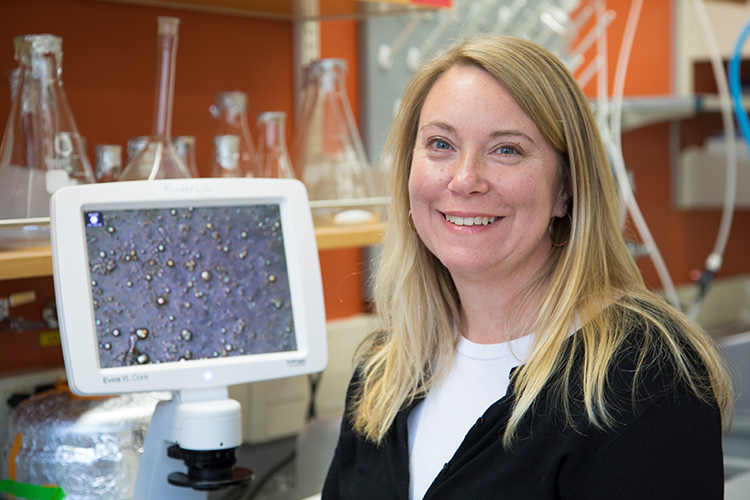
Rebecca Klaper, an aquatic toxicologist at UWM’s School of Freshwater Sciences, is looking for ways to change the chemistry of nanoparticles in order to reduce their harm to aquatic creatures. (UWM Photo/Pete Amland)
Nanoparticles are tiny bits of material – smaller than a blood cell – that are manufactured and integrated into a multitude of commercial products because of their unique properties. Nanomaterials can shed from the use or manufacture of these products into the environment and potentially cause problems.
Scientists don’t know what happens inside our bodies when our cells come into contact with many of these nanoparticles.
To address the issue, the National Science Foundation Division of Chemistry has renewed a five-year $20 million grant that supports the NSF Center for Sustainable Nanotechnology, a collaboration among UW-Madison, UW-Milwaukee and 11 other institutions. The center seeks ways to engineer man-made nanoparticles to ensure that they are safe from the start.
How to reduce negative impact
About $1.3 million of the renewal money will back research by aquatic toxicologist Rebecca Klaper at UWM’s School of Freshwater Sciences. Klaper’s research aims to determine how these nanomaterials interact with aquatic organisms and how altering the chemistry of these particles can decrease the potential negative impacts on the environment.
“We’re trying to create technology that is beneficial but environmentally safe at the same time,” Klaper said. “We want to know which nanoparticles can harm and then how we can alter their structure on the molecular level to mitigate that.”
The center investigates fundamental chemical and physical principles of the multitude of types of nanoparticles, and the problem calls for an interdisciplinary approach, said center director Robert Hamers, a professor of chemistry at UW-Madison. “Engineered nanomaterials have not been in the environment for a long time, so biological systems have not adapted to challenges they present,” he said.
Klaper’s previous work has shown toxic effects in some fish exposed to certain kinds of nanoparticles. Part of what Klaper brings to the center is the ability to analyze changes in an organism’s genes using equipment at the school’s Great Lakes Genomic Center, which she directs.
Using “sub-lethal” exposure, Klaper’s lab looks for changes in how an organism’s genes are expressed – which genes are turned “off” or “on” – in response to exposure over time. Changes to the genome, which are instructions that direct how an organism functions, can be indicative of damage that could affect reproduction and survival in the long run.
Significant results
Work by the center’s scientists have had significant results identifying properties that make nanomaterials harmful and how organisms can differ in their response to exposure. Klaper has been involved in research about altering the chemical structure and physical properties of some metal oxide nanoparticles used in lithium-ion batteries and identifying similarities in the way organisms react to nanoparticle exposures across the animal kingdom.
“The NSF Centers for Chemical Innovation (CCIs) are transforming the way we do science by engaging interdisciplinary, multi-institutional teams to take on grand challenges in the field,” said David Berkowitz, division director of chemistry. “The Center for Sustainable Nanotechnology, one of the CCIs, is performing important research that will guide the development of sustainable nanotechnologies, a key element of the industries of the future.”
Besides UW-Madison and UW-Milwaukee, research partners on the grant include the University of Minnesota, the University of Illinois, Boston University, University of California-Riverside, the University of Maryland-Baltimore County, Johns Hopkins University, the University of Iowa, Augsburg College, Georgia Institute of Technology, Connecticut Agricultural Experiment Station and Pacific Northwest National Laboratory.
